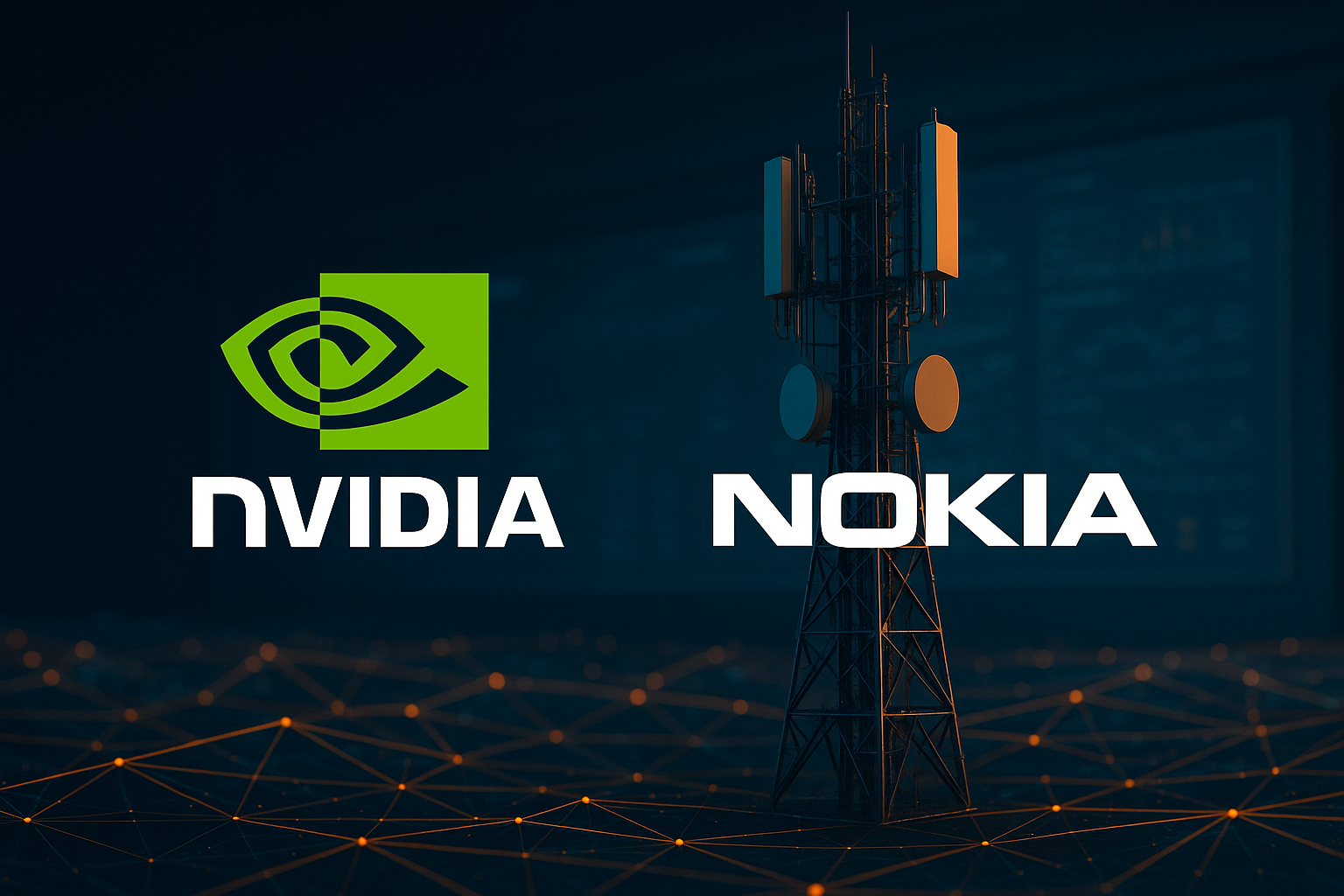🎙️ Betweenplays Media Feature – Not Financial Advice
NVIDIA and Nokia: AI for Telcos or Telcos for AI?
The telecommunications world recently witnessed a landmark announcement: a strategic partnership between NVIDIA and Nokia, underscored by a $1 billion equity investment from NVIDIA into the Finnish network giant.
This collaboration—aimed at building the foundation for AI-native 5G-Advanced and 6G networks—represents the convergence of two powerful legacies that have profoundly shaped modern technology.
But is this deal about bringing AI to telecommunications (AI for Telcos), or about leveraging telecom infrastructure for the global AI supercycle (Telcos for AI)?
This question underlies the entire strategic maneuver.
📜 A History of Convergence: From Paper Mills to GPUs
Nokia: The Architect of Global Connectivity 🇫🇮
Nokia’s journey to telecommunications leadership began far from mobile phones.
Founded in 1865 as a Finnish pulp mill, the company’s pivotal moment came in the early 1990s when it helped develop and deploy the Global System for Mobile Communications (GSM) standard.
Today, Nokia remains a major supplier of core and Radio Access Network (RAN) equipment, constantly evolving its systems to support next-generation connectivity.
Its goal: total network optimization and control — AI for Telcos.
NVIDIA: The Engine of Accelerated Computing 🇺🇸
Founded in 1993, NVIDIA evolved from specialized graphics hardware to a general-purpose computing platform.
The invention of the Graphics Processing Unit (GPU) in 1999, followed by the CUDA architecture in 2006, unlocked massive parallel-processing power.
This made NVIDIA indispensable to the global AI revolution—Telcos for AI—as the core infrastructure provider for all data-intensive, real-time AI workloads.
🔑 The Human and Strategic Nexus: The Path to Partnership
This collaboration was driven by both complementary technologies and aligned leadership:
- Key Leadership Drivers: Jensen Huang (Founder and CEO, NVIDIA) and Justin Hotard (President and CEO, Nokia) spearheaded the partnership.
Huang’s statement that “AI-RAN will revolutionize telecommunications” underscores NVIDIA’s long-term commitment to this transformation. - Prior Collaboration: Both are founding members of the AI-RAN Alliance, launched in February 2024 to accelerate AI’s integration into network infrastructure.
- Trial Partner: T-Mobile U.S. is the early trial partner, with live AI-RAN trials slated for 2026.
🎯 Core Use Cases: The Dual Purpose of AI-RAN
AI-RAN solutions serve two overlapping purposes:
- Use AI to optimize networks.
- Use networks to deploy AI.
| Announced Use Case | Primary Strategic Spin | Win-Win for NVIDIA & Nokia | Benefit for Consumers |
| Spectral Efficiency & Optimization | AI for Telcos | NVIDIA sells high-margin accelerators; Nokia differentiates RAN performance | Faster speeds, less congestion |
| Edge AI Inferencing | Telcos for AI | NVIDIA expands CUDA to the telco edge; Nokia monetizes distributed compute | Better AR/VR, low latency |
| Transition to 6G | Dual Strategy — Future-proofing both network and compute architecture | NVIDIA becomes compute layer for 6G; Nokia keeps anyRAN central | Future-proofed mobile experiences |
| AI Networking Solutions | AI for Telcos | NVIDIA sells Spectrum-X™; Nokia delivers intelligent end-to-end infrastructure | Greater stability and integration |
🔮 Foreseeable AI-RAN Use Cases: The Tug-of-War for Resources
| Foreseeable Use Case | Primary Strategic Spin | Win-Win for NVIDIA & Nokia | Enterprise Impact |
| AI-Native Proactive Security | AI for Telcos | NVIDIA proves real-time capabilities; Nokia leads in resilience | Instant detection of threats |
| AI-Native Energy Management | AI for Telcos | NVIDIA advances green-AI narrative; Nokia reduces Operating Expenditure (OpEx) | Lower carbon footprint |
| Digital Twins for Network Planning | Dual Strategy | NVIDIA extends Omniverse; Nokia speeds deployment while reducing Capital Expenditure (CapEx) risk | Faster, lower-risk rollouts |
| Hyper-Personalized Quality of Experience (QoE) | Telcos for AI | NVIDIA justifies accelerated compute; Nokia offers premium tiers, increasing Average Revenue Per User (ARPU) | Tailored, reliable connectivity |
🌍 The Green Impact and Social Shift: AI-RAN as a Force for Sustainability
⚡ Energy and Green Impact
- Computational Efficiency: Integrating NVIDIA GPUs and the CUDA platform allows a single, efficient compute unit to handle both radio signal processing and AI algorithms—reducing hardware requirements and energy consumption.
- Network Optimization & Energy Savings:
AI-driven power management can cut RAN energy use by up to 25–40%, depending on network conditions and deployment scale, as shown in studies by Tata Communications and Ericsson.[1][2]
This translates directly into a reduced carbon footprint, helping Telcos meet their sustainability goals.
🧑🤝🧑 Social and Ethical Dimensions
- Bridging the Digital Divide:
AI-based predictive network planning makes rural deployments cheaper, expanding access to education and telehealth services. - Democratizing Access to AI:
Edge inferencing brings high-performance AI closer to users, enabling critical services such as telemedicine and emergency response.
🚀 Conclusion: The Unwritten Chapter — AI for Telcos or Telcos for AI?
The NVIDIA–Nokia alliance signifies the end of legacy networks and the dawn of the AI-native era.
Yet, the question remains:
- Is AI merely enhancing the network (AI for Telcos)?
- Or is the network becoming the new global compute grid (Telcos for AI)?
With $1 billion in capital and a shared focus on Edge Computing, the future may belong to ubiquitous intelligence, not just connectivity.
The ultimate outcome will depend on how much of the network’s compute is devoted to self-optimization versus external AI monetization—a balance that will define the next chapter of the digital age.
To be or not to be…
Authors Note
This article was co-authored by Andrea Turno and Sandeep Panesar, both regular writers for Betweenplays.com
🧩 Sources & References
- NVIDIA and Nokia Strategic Partnership (USD 1 Billion Equity Investment) — Nokia Press Release, October 2025.
https://www.nokia.com/newsroom/inside-information-nvidia-to-make-usd-1-billion-equity-investment-in-nokia-in-addition-to-new-strategic-partnership-nokias-board-resolved-on-directed-share-issuance-to-nvidia - Tata Communications – AI-Powered RAN Energy Efficiency Case Study (2024).
https://www.tatacommunications-ts.com/use-cases/enhancing-ran-energy-efficiency-through-ai-powered-intelligent-automation - Ericsson Blog – AI-Powered RAN Energy Efficiency Results (2023).
https://www.ericsson.com/en/blog/2023/1/ai-powered-ran-energy-efficiency - AI-RAN Alliance Announcement — February 2024.
https://www.airanalliance.org/news/founding-members - NVIDIA Corporate Timeline — CUDA Architecture (2006).
https://www.nvidia.com/en-us/about-nvidia/corporate-timeline - History of Nokia — GSM Development and Evolution.
https://en.wikipedia.org/wiki/History_of_Nokia - SoftBank Research (2024) — Edge AI and Public Safety Applications.
https://www.softbank.jp/en/sbnews/entry/2024/edge-ai-research - T-Mobile U.S. Trials with Nokia and NVIDIA — Nokia Press Release.
https://www.nokia.com/news/releases/2024/02/ai-ran-trials-tmobile-nokia-nvidia

⚠️Betweenplays Media Disclaimer
Betweenplays Media™ is an independent research and educational platform. All articles, visuals, and commentaries are created for informational and entertainment purposes only. They do not constitute financial advice, investment recommendations, or endorsements of any securities, strategies, or entities mentioned. All opinions expressed reflect the authors’ independent analysis at the time of publication. Readers should conduct their own due diligence or consult licensed financial professionals before making any investment or strategic decisions.
© Betweenplays Media Inc. — All Rights Reserved.All content protected under international copyright and trademark law.
